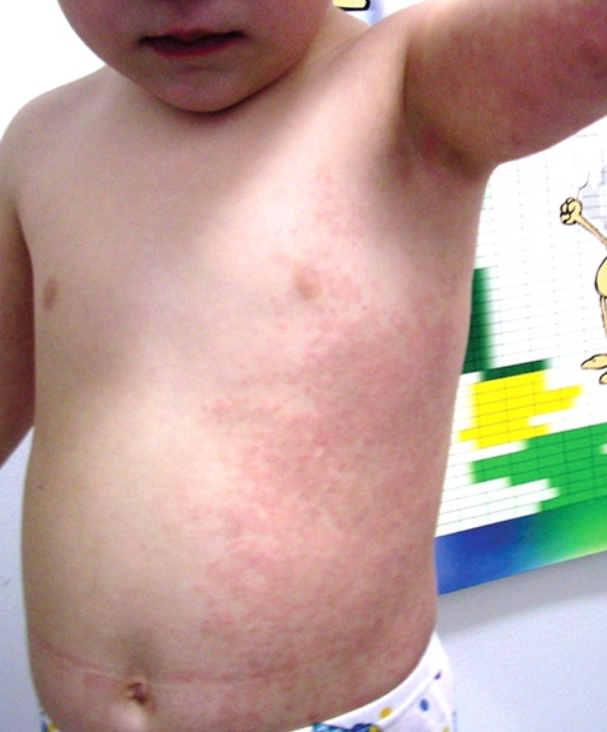Childhood Asymmetric Periflexural Exanthem (also known as Unilateral Laterothoracic Exanthem) is a spontaneously resolving exanthem in young children characterized by unilateral eruptions on the skin folds and trunk. ICD-10 Code: B09
The condition occurs in children between the ages of 6 months and 10 years (typically around 24 months), although a few isolated cases with a similar clinical presentation have been described in adults. Girls are twice as likely to be affected as boys. The disease is prevalent in Europe and North America and is more common in late winter and spring.
The exact cause is unknown. Numerous attempts to identify the causative agent by screening for influenza viruses, rubella, parvovirus B19, Epstein-Barr virus, cytomegalovirus, herpesvirus 1, 6, 7, 8 types, picornavirus, adenovirus, enterovirus, hepatitis B virus, coxsackievirus, and bacteria such as rickettsia, borrelia, spiroplasma, or mycoplasma have been unsuccessful. Some theories suggest that the disease may be associated with reactivation of the Epstein-Barr virus, although this may be an epiphenomenon.
However, the presence of a prodrome with fever, familial cases, outbreaks in childcare settings, seasonality, spontaneous remission, and lack of response to antibiotic therapy suggest a viral etiology of the disease, possibly caused not by a single pathogen but by co-infection with multiple agents.
The disease begins with a prodrome lasting several days to 3 weeks and characterized by mild fever, diarrhea, and respiratory symptoms.
The rash develops in two stages:
In the first stage, there is a sudden onset of small, 1-2 mm in diameter, isolated pink-red macules and papules, often surrounded by a narrow pale halo, which merge into erythematous plaques with festooned margins. In addition to the maculopapular rash, vesicles, bullae and petechiae may be seen. In 95% of cases, the initial localization of the rash is in the axillary area, in other cases it may be in the groin area, and rarely in the popliteal fossae. The rash is always unilateral.
During the first week, the rash spreads centrifugally to the chest, inner surface of the arms, thighs, buttocks, and occasionally to the face and proximal parts of the limbs, with affected areas alternating with healthy skin. Two characteristic signs when the rash is demonstrated by children or parents are the "Statue of Liberty" sign, in which one arm is raised, and the "parachutist jump" sign, in which both arms are raised simultaneously. As the disease progresses, the plaques become more erythematous and often take on a circular shape.
On the 8th or 9th day of illness, a localized lesion occurs on one side of the chest, even if the rash was initially present on other parts of the body. The mucous membranes, palms and soles are not affected. Pruritus is noted in 50% of cases, but excoriation is absent. Subfebrile fever is seen in about 40% of cases and lymphadenopathy in more than half of cases.p> The second stage of rash development occurs on day 8-15 and is characterized by the appearance of eruptions on the opposite side of the body and on the distal parts of the limbs, but the initial side of involvement always looks more prominent. It is observed in 65-70% of patients and lasts for 2-4 weeks. In the third week, the rash begins to fade with central resolution and superficial scaling, which continues for 4-5 weeks. By week 6, all signs of disease disappear. In rare cases, a recurrent course of the disease is possible, and sometimes the rash may persist for up to four months.
- Guttate psoriasis
- Contact allergic dermatitis
- Drug eruption
- Viral exanthems
- Gianotti-Crosti syndrome
- Tinea corporis
- Scabies
- Scarlet fever
- Atopic dermatitis
- Papular urticaria

